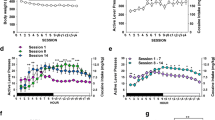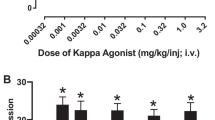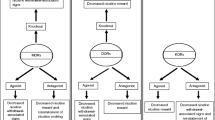Abstract
Rationale
Several lines of evidence support a role for the endogenous opioid system in mediating behaviors associated with drug dependence. Specifically, recent findings suggest that the kappa-opioid receptor (KOR) may play a role in aspects of nicotine dependence, which contribute to relapse and continued tobacco smoking.
Objective
The objective of this study is to determine the involvement of the KOR in the initial behavioral responses of nicotine, nicotine reward, and nicotine withdrawal using the highly selective KOR antagonist JDTic. JDTic doses of 1, 4, 8, or 16 mg/kg were administered subcutaneously (s.c.) 18 h prior to nicotine treatment.
Results
JDTic dose-dependently blocked acute nicotine-induced antinociception in the tail-flick but not the hot-plate test and did not significantly attenuate morphine's antinociceptive effect in either the tail-flick or hot-plate test. Furthermore, JDTic (8 and 16 mg/kg, s.c.) failed to block the expression of nicotine reward as measured by the conditioned place preference model. In contrast, JDTic and the KOR antagonist norBNI attenuated the expression of both the physical (somatic signs and hyperalgesia) and affective (anxiety-related behavior and conditioned place aversion) nicotine withdrawal signs.
Conclusions
Our findings clearly show that the KOR is involved in mediating the withdrawal aspects of nicotine dependence. The results from this study suggest that blockade of the KOR by selective KOR antagonists may be useful smoking cessation pharmacotherapies.





Similar content being viewed by others
References
Bals-Kubik R, Ableitner A, Herz A, Shippenberg TS (1993) Neuroanatomical sites mediating the motivational effects of opioids as mapped by the conditioned place preference paradigm in rats. J Pharmacol Exp Ther 264:489–495
Beardsley PM, Howard JL, Shelton KL, Carroll FI (2005) Differential effects of the novel kappa opioid receptor antagonist, JDTic, on reinstatement of cocaine-seeking induced by footshock stressors vs cocaine primes and its antidepressant-like effects in rats. Psychopharmacology (Berl) 183:118–126
Berrendero F, Kieffer BL, Maldonado R (2002) Attenuation of nicotine-induced antinociception, rewarding effects, and dependence in mu-opioid receptor knock-out mice. J Neurosci 22:10935–10940
Berrendero F, Mendizabal V, Robledo P, Galeote L, Bilkei-Gorzo A, Zimmer A, Maldonado R (2005) Nicotine-induced antinociception, rewarding effects, and physical dependence are decreased in mice lacking the preproenkephalin gene. J Neurosci 25:1103–1112
Campbell VC, Taylor RE, Tizabi Y (2007) Effects of selective opioid receptor antagonists on alcohol-induced and nicotine-induced antinociception. Alcohol Clin Exp Res 31:1435–1440
Carlezon WA Jr, Beguin C, DiNieri JA, Baumann MH, Richards MR, Todtenkopf MS, Rothman RB, Ma Z, Lee DY, Cohen BM (2006) Depressive-like effects of the kappa-opioid receptor agonist salvinorin A on behavior and neurochemistry in rats. J Pharmacol Exp Ther 316:440–447
Carroll FI, Thomas JB, Dykstra LA, Granger AL, Allen RM, Howard JL, Pollard GT, Aceto MD, Harris LS (2004) Pharmacological properties of JDTic: A novel κ-opioid receptor antagonist. Eur J Pharmacol 501:111–119
Carroll FI, Harris LS, Aceto MD (2005) Effects of JDTic, a selective kappa-opioid receptor antagonist, on the development and expression of physical dependence on morphine using a rat continuous-infusion model. Eur J Pharmacol 524:89–94
Chavkin C, James IF, Goldstein A (1982) Dynorphin is a specific endogenous ligand of the kappa opioid receptor. Science 215:413–415
Christensen MK, Smith DF (1990) Antinociceptive effects of the stereoisomers of nicotine given intrathecally in spinal rats. J Neural Transm Gen Sect 80:189–194
Damaj MI (2000) The involvement of spinal Ca(2+)/calmodulin-protein kinase II in nicotine-induced antinociception in mice. Eur J Pharmacol 404:103–110
Damaj MI, Fei-Yin M, Dukat M, Glassco W, Glennon RA, Martin BR (1998) Antinociceptive responses to nicotinic acetylcholine receptor ligands after systemic and intrathecal administration in mice. J Pharmacol Exp Ther 284:1058–1065
D'Amour FE, Smith DL (1941) 74A method for determining loss of pain sensation. J Pharmacol Exp Ther 72:74–79
Galeote L, Kieffer BL, Maldonado R, Berrendero F (2006) Mu-opioid receptors are involved in the tolerance to nicotine antinociception. J Neurochem 97:416–423
Galeote L, Maldonado R, Berrendero F (2008) Involvement of kappa/dynorphin system in the development of tolerance to nicotine-induced antinociception. J Neurochem 105:1358–1368
Galeote L, Berrendero F, Bura SA, Zimmer A, Maldonado R (2009) Prodynorphin gene disruption increases the sensitivity to nicotine self-administration in mice. Int J Neuropsychopharmacol 12:615–625
Hahn B, Stolerman IP, Shoaib M (2000) Kappa-opioid receptor modulation of nicotine-induced behaviour. Neuropharmacology 39:2848–2855
Hughes JR, Hatsukami D (1986) Signs and symptoms of tobacco withdrawal. Arch Gen Psychiatry 43:289–294
Isola R, Zhang H, Duchemin AM, Tejwani GA, Neff NH, Hadjiconstantinou M (2002) Met-enkephalin and preproenkephalin mRNA changes in the striatum of the nicotine abstinence mouse. Neurosci Lett 325:67–71
Isola R, Zhang H, Tejwani GA, Neff NH, Hadjiconstantinou M (2008) Dynorphin and prodynorphin mRNA changes in the striatum during nicotine withdrawal. Synapse 62:448–455
Isola R, Zhang H, Tejwani GA, Neff NH, Hadjiconstantinou M (2009) Acute nicotine changes dynorphin and prodynorphin mRNA in the striatum. Psychopharmacology (Berl) 201:507–516
Jackson KJ, Martin BR, Changeux JP, Damaj MI (2008) Differential role of nicotinic acetylcholine receptor subunits in physical and affective nicotine withdrawal signs. J Pharmacol Exp Ther 325:302–312
Jackson KJ, Kota DH, Martin BR, Damaj MI (2009) The role of various nicotinic receptor subunits and factors influencing nicotine conditioned place aversion. Neuropharmacology 56:970–974
Jarvis MJ (2004) Why people smoke. Brit J Med 328:277–279
Jensen RA, Gilbert DG, Meliska CJ, Landrum TA, Szary AB (1990) Characterization of a dose-response curve for nicotine-induced conditioned taste aversion in rats: relationship to elevation of plasma beta-endorphin concentration. Behav Neural Biol 53:428–440
Knoll AT, Meloni EG, Thomas JB, Carroll FI, Carlezon WA Jr (2007) Anxiolytic-like effects of κ-opioid receptor antagonists in models of unlearned and learned fear in rats. J Pharmacol Exp Ther 323:838–845
Kota D, Martin BR, Robinson SE, Damaj MI (2007) Nicotine dependence and reward differ between adolescent and adult male mice. J Pharmacol Exp Ther 322:399–407
Land BB, Bruchas MR, Lemos JC, Xu M, Melief EJ, Chavkin C (2008) The dysphoric component of stress is encoded by activation of the dynorphin kappa-opioid system. J Neurosci 28:407–414
Mague SD, Pliakas AM, Todtenkopf MS, Tomasiewicz HC, Zhang Y, Stevens WC Jr, Jones RM, Portoghese PS, Carlezon WA Jr (2003) Antidepressant-like effects of kappa-opioid receptor antagonists in the forced swim test in rats. J Pharmacol Exp Ther 305:323–330
Malin DH, Lake JR, Carter VA, Cunningham JS, Wilson OB (1993) Naloxone precipitates nicotine abstinence syndrome in the rat. Psychopharmacology (Berl) 112:339–342
Mansour A, Fox CA, Akil H, Watson SJ (1995) Opioid-receptor mRNA expression in the rat CNS: anatomical and functional implications. Trends Neurosci 18:22–29
Markou A (2008) Review. Neurobiology of nicotine dependence. Philos Trans R Soc Lond B Biol Sci 363:3159–3168
Marty MA, Erwin VG, Cornell K, Zgombick JM (1985) Effects of nicotine on beta-endorphin, alpha MSH, and ACTH secretion by isolated perfused mouse brains and pituitary glands, in vitro. Pharmacol Biochem Behav 22:317–325
McLaughlin JP, Chavkin C (2003) Stress-induced activation of endogenous kappa opioid systems potentiates cocaine response International Narcotics Research Conference, Perpignan, France, Abstract 119
Paterson NE (2009) Behavioural and pharmacological mechanisms of bupropion's anti-smoking effects: recent preclinical and clinical insights. Eur J Pharmacol 603:1–11
Pfeiffer A, Brantl V, Herz A, Emrich HM (1986) Psychotomimesis mediated by kappa opiate receptors. Science 233:774–776
SAMHSA (Substance Abuse and Mental Health Services Administration) (2009) Results from the 2008 National Survey on Drug Use and Health. Department of Health and Human Services, Washington, DC
Shippenberg TS, Zapata A, Chefer VI (2007) Dynorphin and the pathophysiology of drug addiction. Pharmacol Ther 116:306–321
Shirayama Y, Ishida H, Iwata M, Hazama GI, Kawahara R, Duman RS (2004) Stress increases dynorphin immunoreactivity in limbic brain regions and dynorphin antagonism produces antidepressant-like effects. J Neurochem 90:1258–1268
Thomas JB, Atkinson RN, Vinson NA, Catanzaro JL, Perretta CL, Fix SE, Mascarella SW, Rothman RB, Xu H, Dersch CM, Cantrell BE, Zimmerman DM, Carroll FI (2003) Identification of (3R)-7-hydroxy-N-((1S)-1-[[(3R, 4R)-4-(3-hydroxyphenyl)-3, 4-dimethyl-1-piperidinyl]methyl]-2-methylpropyl)-1, 2, 3, 4-tetrahydro-3-isoquinolinecarboxamide as a novel potent and selective opioid kappa receptor antagonist. J Med Chem 46:3127–3137
Todtenkopf MS, Marcus JF, Portoghese PS, Carlezon WA Jr (2004) Effects of kappa-opioid receptor ligands on intracranial self-stimulation in rats. Psychopharmacology (Berl) 172:463–470
Walters CL, Brown S, Changeux JP, Martin B, Damaj MI (2006) The beta2 but not alpha7 subunit of the nicotinic acetylcholine receptor is required for nicotine-conditioned place preference in mice. Psychopharmacology (Berl) 184:339–344
Wewers ME, Dhatt RK, Snively TA, Tejwani GA (1999) The effect of chronic administration of nicotine on antinociception, opioid receptor binding and met-enkelphalin levels in rats. Brain Res 822:107–113
Zimmer A, Valjent E, Konig M, Zimmer AM, Robledo P, Hahn H, Valverde O, Maldonado R (2001) Absence of Δ-9-tetrahydrocannabinol dysphoric effects in dynorphin-deficient mice. J Neurosci 21:9499–9505
Acknowledgments
The authors wish to thank Cindy Evans and Tie Han for their technical contributions to this study. This work was supported by National Institute on Drug Abuse grants DA12610, DA005274, NS070715, and DA009045.
Author information
Authors and Affiliations
Corresponding author
Rights and permissions
About this article
Cite this article
Jackson, K.J., Carroll, F.I., Negus, S.S. et al. Effect of the selective kappa-opioid receptor antagonist JDTic on nicotine antinociception, reward, and withdrawal in the mouse. Psychopharmacology 210, 285–294 (2010). https://doi.org/10.1007/s00213-010-1803-1
Received:
Accepted:
Published:
Issue Date:
DOI: https://doi.org/10.1007/s00213-010-1803-1




